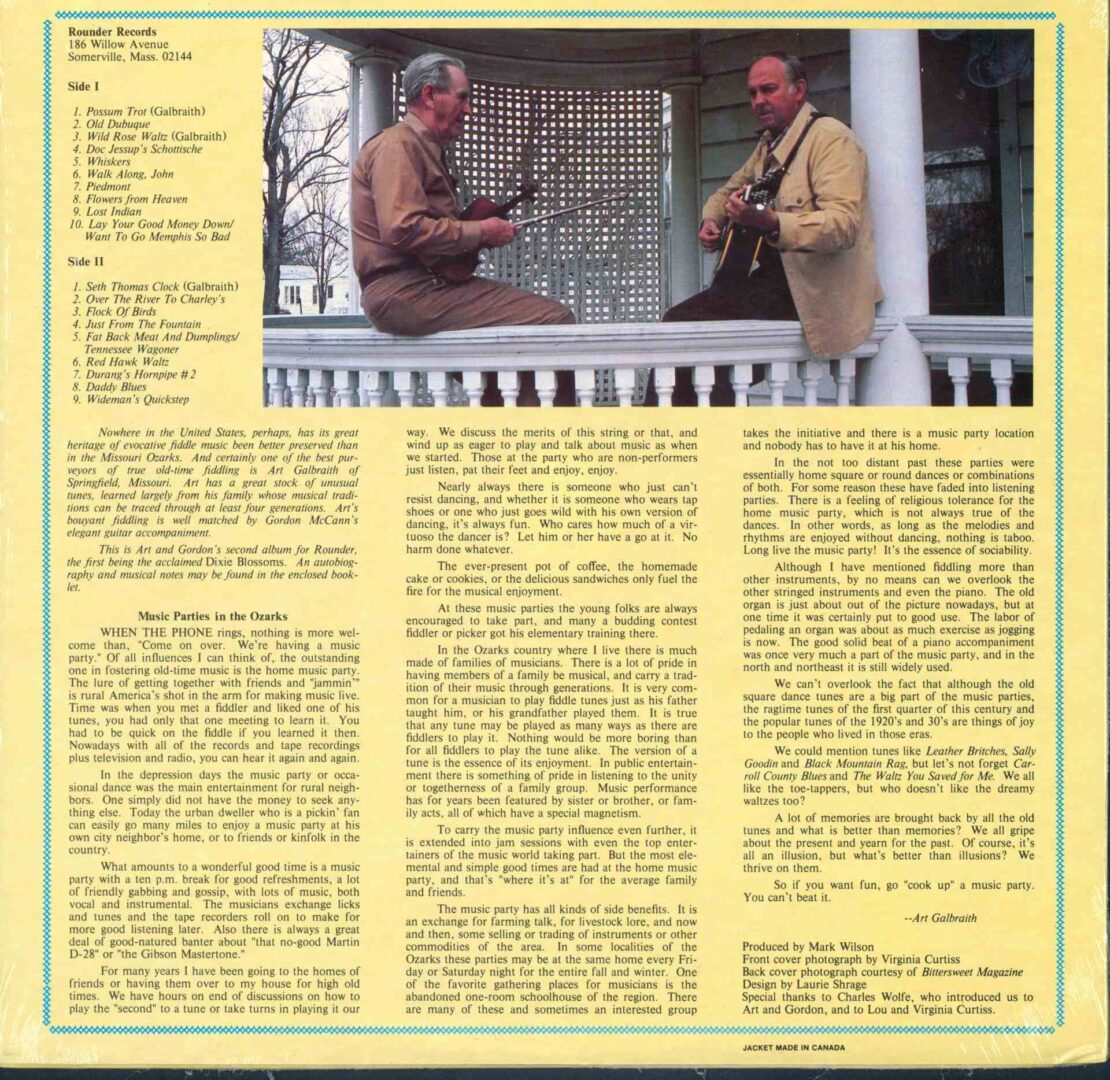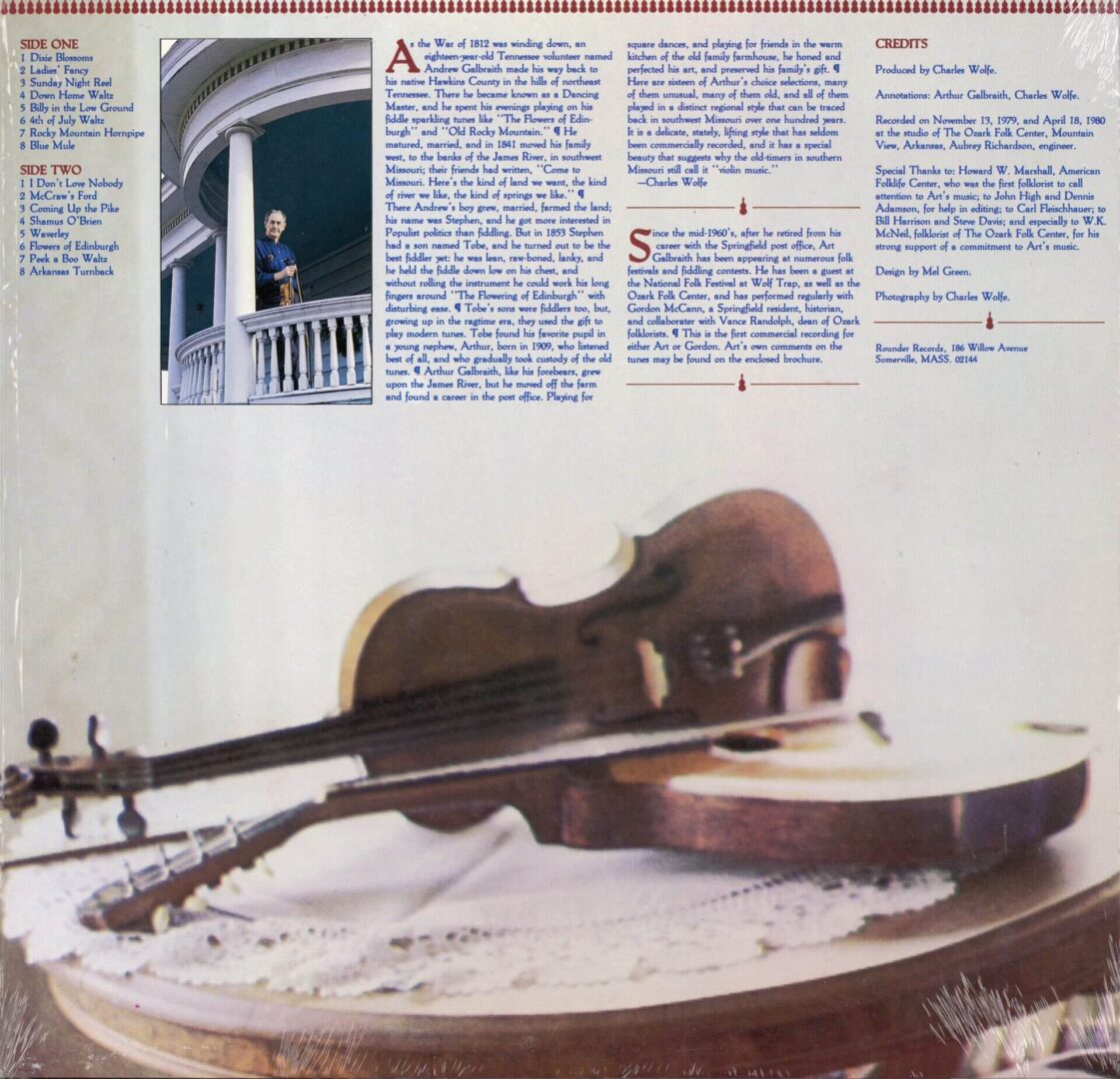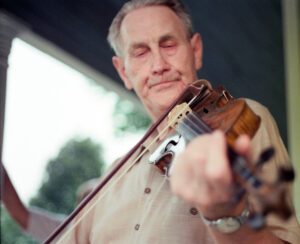ART GALBRAITH
“POSSUM TROT is my own composition from the early 1950's. I played it for an exhibition square dance in St. Louis at the National Folk Festival in 1951. It has a good beat and the dancers really enjoyed dancing to it. It is played in A.”
“OLD DUBUQUE, sometimes known as Dubuque's Hornpipe, is in D with a beautiful b minor strain and I have known it since Uncle Tobe played it. I think he called it by still another name; maybe the name of the man from whom he learned it. I have also heard it called Lighthouse. (A transcription may be found in R.P. Christeson's The Old Time Fiddler's Repertory) I have heard this played in Kentucky as Trouble Down in Georgia and ii appears in E. T Adam's collection as Fiddling Phil. Art's friend, Emanuel Wood, recorded this and several other pieces learned from him on I'm Old But I'm Awfully Tough (Missouri Friends of the Folk Arts LP”
“WILD ROSE WALTZ represents a composite of several old-time pieces including the original Rose Waltz, and was completed by me in trying to remember some of the old tunes. In other words, it is one half my composition. (The standard Rose Waltz can be found in Christeson 's book and heard, played by Bob Wailers, on the accompanying record.”
“DOC JESSUP’S SCHOTTISCHE is played by Glen Rickman, a fiddler friend of mine, and I picked it up from him. I presume it was named for a local doctor who probably composed it or remembered it from long ago.”
“WHISKERS is one of many tunes of the first quarter of this century that are a mixture of rags, blues and whatever. It is in C with an A D G C part. It is a tune that always sets toes to tapping. It is one of the first tunes that used this circle of fifths chord progressions as far as I know and many years ago was considered a sort of show-off piece. (This is a progenitor of the well-known Stone's Rag, popularized by Oscar Stone on the old Grand Ole Opry. Art also plays this piece. David Jasen comments that the first strain of Percy Wenrich 's Persian Lamb Rag was based on "an old fiddle tune called Whiskers". Although the i present tune and Wenrich's strain (available on Those Ragtime Banjos, RBF 40) are not identical, they seem related. Wenrich was from Joplin, Missouri and this fact leads one to wonder to what extent classic ragtime derived from country fiddle tunes like Art's.”
“WALK ALONG, JOHN is an old, old, fiddle tune which like so many early tunes had words that were sung alternating with the instrumental. My mother used to sing: "Walk along John with your paper collar on" to it. It has a haunting minor part. The tune is played in G. (A number of Walk Along, John titles appear in the minstrel literature of the 1840's. It is suspected that Art's piece is connected to the Git Along, John printed in Lloyd's Ethiopian Song Book of 1847:
Den git along, John; oh, git along, John
Den git along, John, de fifer's son
Ain't you mighty glad your work's most done?
Versions of this fiddle tune can be found in Christeson 's book as well as Marion Thede's The Fiddle Book.”
“PIEDMONT is a tune I learned from Uncle Tobe. I think it is a version of something very old, possibly a hornpipe or reel from Scotland. It is in the key of D.”
“FLOWERS FROM HEAVEN is in B-flat and my version is somewhat similar to that of Cleo Persinger, who is now dead but was a North Missouri fiddler of some years ago.”
“LOST INDIAN is played in A in a cross-key tuning, and is one of probably dozens of versions. My friend Glen Rickman calls it "Cross-eyed A" tuning. There's not much to the tune and I don't yell or whoop as I play it as some players do, mainly because I can't do that at all. (An early transcription of another Missouri version can be found in E.T. Adams' Old-Time Fiddlers Favorite Barn Dance Tunes, recently reprinted (without credits) as Mel Bay's Old Time Fiddle Solos. This tune is the ancestor of the popular Black Mountain Rag. (ed.))”
“LAY YOUR GOOD MONEY DOWN, more often called Good Money, is an old tune in D which my family often played for dancing. It has a good rhythm and three different parts. Clay Galbraith, my cousin, often added another tune which he had heard or had made up. He called that fourth part Want to Go to Memphis So Bad. It wasn't related to Good Money except it fitted in to relieve the monotony of playing the same strains over and over for a square dance.”
“SETH THOMAS CLOCK is also my original and on our mantel is a 1907 Seth Thomas Clock which I was looking at when I was trying to perfect the tune. So, what could be a better name?”
“OVER THE RIVER TO CHARLEY’S is a jig and I have no idea if that is the correct name. It is probably one of many tunes by that title. It is played in D.
(The usual words to this well-known play party tune are:
Over the river to feed my sheep
Over the river to Charley's
Over the river to feed my sheep
On sugar cane and barley.
Andrew Lang said that this represents a parody of a 1748 Jacobire
song, noting that it "refers genially 10 That love of ale and
wine which Prince Charles displayed as early as ... the age fourteen."
“OVER THE RIVER TO CHARLEY’S is a jig and I have no idea if that is the correct name. It is probably one of many tunes by that title. It is played in D.
(The usual words to this well-known play party tune are:
Over the river to feed my sheep
Over the river to Charley's
Over the river to feed my sheep
On sugar cane and barley.
Andrew Lang said that this represents a parody of a 1748 Jacobire
song, noting that it "refers genially 10 That love of ale and
wine which Prince Charles displayed as early as ... the age fourteen."
“Jusr ji-om rhe Fou111ain is one of several pieces played by a Dr. Brown, a country doctor of this area many years ago. (Another is McCraw's Ford, available on my first Ip .) I learned it somewhere along the line from my relatives.”
“FAT MEAT AND DUMPLINGS is a tune in C that reminds one of the old banjo tune, Green Corn, and is known by other names including Knocking al the Door. Cyril Stinnett, a left-handed fiddler from north Missouri plays it in a slightly different version. Its progression is exactly like Tennessee Wagoner and I used to play it with that tune as a novelty, just as I have done here.”
“RED HAWK WALTZ or better known as Clark's Waltz is played by a good many Missouri fiddlers. It is played in A. (Art’s friend, the late Lonnie Robertson, plays a nice version on Caney Mountain Records Ip 232. interestingly enough, Gordon McCann plays guitar on that record too!”
“DURANG’S HORNPIPE # 2 is really a version made from the old Durang 's Hornpipe. Many purists would say that it has no connection to it at all. I think that some strains of #2 appear in the original, especially when played by some modern fiddlers (notably those in Texas and Oklahoma). (To my ears, this sounds like an offshoot of the rather amorphous Rocky Mountain Goat 111ne family.”
“DADDY BLUES is played many different ways. Some played it fast and some played it rather slowly. It is a tune that gives the fiddler a lot of leeway for improvising. Many people like it and ask to hear it. It is in the key of G with an E A D G progression which gives the accompanists a chance to vary their playing. (This piece resembles. through its circle of fifths construction, The Salty Dog Blues.”
“WIDEMAN’S QUICKSTEP is partly a tune remembered from Uncle Tobe and his boys and partly a little of my own improvising. My memory of it is not complete. It is played in the keys of G and C, and when I first heard it there was also a D part. This last part I do not remember at all. Perhaps someday, I'll make it all complete.”
“DIXIE BLOSSOMS - I think this comes from the 1916 era. My relatives played; a cousin of mine, especially, who was in World War I, he always played it; my mother liked it so well, every time he was et our house, she'd went "Dixie Blossoms," and he'd play it. And his brother played it. And then Raymond Campbell, e friend of ours from Ozark, he played it a little bit differently. Byron Kelly, an old bass player, the only black man left in Christian County, used to be a professional, he liked this one a lot.”
“LADIES FANCY - This is the name that always heard this tune celled, although I think there are other tunes bearing the same name. It's a good hornpipe end I learned it from members of my family.”
“SUNDAY NIGHT REEL - My own composition dating from about 1960, I think. I have played it for square dancing end it has a good chord progression. We like to play it.”
“DOWN HOME WALTZ - I have played this tune only about ten or twelve years. I have heard it By a fiddler, Warren Dykes, end, also I was influenced by a version by a Canadian.”
“BILLY IN THE LOW GROUND – Now there will be people who say that this tune is not played correctly end it is not like most versions, but I learned it this way end I like the lonesome minor sound of it. My version will count out e little longer than the average. Different structure and different handling make fiddle tunes interesting. If ell fiddlers sounded alike there would be no interest in fiddling.”
“FOURTH OF JULY WALTZ - My own composition. I put it together on July 4, 1976 (Bicentennial Day) end I thought the name was appropriate.”
“ROCKY MOUNTAIN HORNPIPE – I learned this in the twenties from my uncles, Tobe and Mark. They both played it, end said it was the oldest piece they knew, and could trace it back to the 1820' s. They called it "Old Rocky Mountain." If you use your imagination a bit, it has a sort of an Indian beat to it, you know where you see an Indian dance. When I was a boy and first learning that, my mother used to sit and pat both feet to it, and said, ''I always think I'm seeing an Indian dance.'''
“BLUE MULE - This tune I first learned from older members of my family. However, it is played by many Missouri fiddlers, and may have been in influenced by the old play-party tune Skip to my Lou. I remember hearing that sung et play-parties and dancing to it myself. That is really whet play parties were - just dancing to singing and using no instruments. It was believed by many that the instruments were the tools of the devil.”
“I DON'T LOVE NOBODY - Strictly my version after hearing many fiddlers play it - the second pert (A Minor) my own concoction dimly suggested by Tommy Jackson's or Buddy Durham's versions.”
“McCRAW'S FORD - This is the name of a river crossing on the James River near Springfield, Missouri, where I was born and grew up. The story goes that a country doctor named Brown fell asleep in his buggy crossing at the ford one night, and dreamed the tune, woke up, got home, and played it. Lots of people call it "Brown's Dream." My family learned it from the doctor and passed it on to me. Dr. Brown brought me into the world. Later he had a stroke and died in a courtroom.”
“COMING UP THE PIKE - Learned from an old, square dance fiddler around here named Bilyeu. I have played it for about 20 years. It sounds like an old, old tune to me.”
“SHAMUS - (variant of Seamus according to Webster's 2nd edition) O'Brien - Picked this up only three or four years ago - probably first suggested by Cyril Stinnett's version - modified some by my subsequent playing.”
“WAVERLEY - A reel I learned from my Uncle Tobe Galbtaith. I didn't play it at all when first heard it. I remembered it much later and put it on the fiddle.”
“FLOWERS OF EDINBURGH - I learned the basic part of this tune from Uncle Tobe but later on I tried to improve my version. Gordon and I have worked out what I think is a nice version with several minor shadings. I think it's my ell-time favorite tune. I've heard Uncle Tobe play this, and I've also heard him say when he played it, "That's the oldest tune I know, because l know my father played it, and I know he learned it from his grandfather." (Gordon: ''I have this on tape by another Missouri fiddler who plays it as a hoedown, plays the two parts reversed, and still cells it 'Flowers of Edinburgh.')”
“PEEK-A-BOO WALTZ - This is not the old standard Peek-a-Boo, though there are passages in it that make one think of the old standard. This is what some members of my family came up with and it makes a nice slow waltz with good guitar effects which Gordon ably uses.”
“ARKANSAS TURNBACK - Another of Willy Bilyeu's tunes, learned about 1955. I didn't know the name of it when I picked it up – found that out later - it, at first, seemed to remind me of an old hornpipe of another name.”
In this unedited video Luke Cormier (fiddle) and Gordon McCann (guitar) perform old time fiddle tunes from Missouri and discuss a range of topics about music and music-making. Luke is the grandson of Art Galbraith and is learning to play many of the tunes his grandfather played, but with Luke's own particular style. This video was produced in August 2022 by Tony Collins (ieilm.com) in the kitchen of the McCann family home in Springfield, Missouri.










